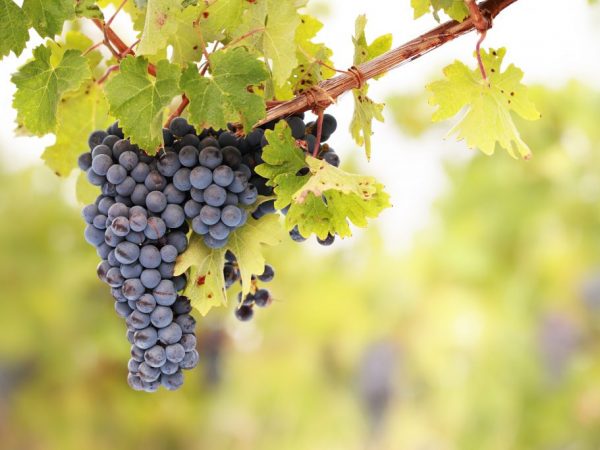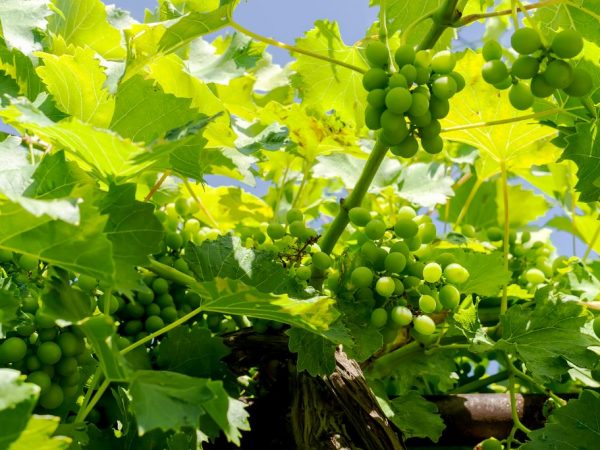Features of Armani grapes
Armani grape is a hybrid grape with early ripeness, large and juicy berries. This is a young species, it is still being tested for resistance to various diseases and pests.

Features of Armani grapes
Species characteristics
The Armani grape variety ripens early, the full cycle is 110 - 120 days.
Armani can withstand frost and frost down to -22 C °. Differs in high yield and excellent transportability.
Description of the bush
The bush is long and tall. The cuttings harden quickly, the root system is powerful. The vine is strong, grows and develops rapidly.
Flowering is active, bisexual, so it does not need additional pollination. The first fruits are removed 2 to 3 years after planting.
Description of fruits
According to the description, the bunches are large, weighing from 800 to 1300 grams. The berries are large, oval in shape, each weighing 17 - 22 grams. The color is purple, close to red. The structure of the bunch is medium, loose.
The berries are tasty, fleshy. The skin is thin, but keeps its shape well and for a long time. There are bones.
Growing grapes
When planting grapes, choose a suitable place for this. Armani will not grow or bear fruit in the shade. The place should be sunny and free of drafts.
Landing in the soil
Planting depends on the type of soil. If the soil is sandy, then the grapes are planted in special trenches. Loams, clayey soil and places with a close location of groundwater - in such cases, planted in "creative".
To plant a seedling, it is necessary to dig a hole 70x70 cm in size. The bottom should be at least 50 cm. First, humus and other mineral fertilizers are poured into the hole, then a seedling is placed there and covered with earth tightly. After the bush, you need to pour 2-3 buckets of water. When the top layer dries up, the earth is loosened.
Plant care
Armani variety is demanding in care:
| Month | Work description |
| March | Pruning unrooted varieties before the first buds appear on the vine. |
| April | After the spring frosts have passed, the grapes are freed from the winter shelter. |
| May | The vine and its new shoots are tied up, the extra ones break off. |
| June | The bush is tied up tighter, extra bunches are pinned. |
| July | Treatment of grapes with antifungal drugs. |
| August | Feeding the root system with phosphorus and potassium. |
| September | Harvesting. |
| October | The fallen leaves are removed, the earth is dug up. |
| November | Watering and clogging the shoots in the winter shelter. |
From December to February, the vineyards are resting. Be sure to hide the vine well from winter frost and snow.
Plant fertilization

Not all trace elements are needed by a plant
If during the planting of the seedling fertilizers or an organic "pillow" were added, then the next 2 - 3 years no additional feeding is needed. Adult bushes need individual trace elements:
- nitrogen;
- potassium;
- zinc;
- phosphorus;
- copper;
- boron
These are the main elements for fertilizing the vine, the grapes do not need other substances, they are contained in the right amount in the soil.
Watering
Armani table grapes are watered 4 times a year:
- The first watering is carried out in early spring, when the frost has receded. The bushes are opened, tied up and watered with 3 to 4 buckets of water.
- The second is a week or two before flowering. You will also need 3 to 4 buckets.
- The next one is after flowering. It is less plentiful, with about 2-3 buckets of water. When the berries begin to pour and color, watering stops.
- The latter is held a week before the winter shelter. This is abundant watering with the addition of essential minerals to the water.
If the summer is excessively dry, then sprinkle with a little water.
Diseases and pests
Armani is susceptible to various pests, viral, infectious and fungal diseases. Poor quality care and untimely treatment leads to a loss of 60% of the crop.
Fight disease
Treatment depends on the type of disease. Most of the diseases are treated with systemic fungicides - Bordeaux mixture, Antracol, Thanos, etc.
The most dangerous are fungal diseases. They become chronic. Treatment is carried out with a special chemical treatment and systemic fungicides.
Pest control
Vineyards attract the attention of over 700 types of pests. They damage not only the crop, but also the root system, leaves and bark. To treat and repel the bulk of pests, specially selected chemicals are used.
The main grape pest is wasps. In August, they can destroy the entire crop. In the fight against insects, treat the leaves with special repellants, and also regularly destroy wasp hives.
Prophylaxis
Prevention is the correct and timely care of the plant. By following the recommendations, 60% of diseases can be avoided.
In the autumn period, attention should be paid to harvesting fallen leaves, proper shelter. In spring and summer, maximum care will be required. Frequent inspection of the leaves and bark can help identify early stages of the disease or parasite.
Conclusion
The Armani grape is a table variety. It is not well suited for winemaking, but it is a great dessert on its own.
Frost resistance and high yields make the variety popular with vineyards. It is a good kind for sale and long-term storage.


